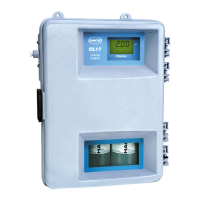Page 40
Instrument Menu Structure
54400_start.fm
Section 2
•PRIME—This feature causes the analyzer to make 39 concurrent
accelerated cycles to prime the reagent lines. Press
ENTER to activate. At
the end of 39 cycles, the analyzer will return to normal operation. To
terminate the prime cycle before all 39 cycles are complete, press
EXIT.
The analyzer will return to normal operation.
•CLEAN—This feature stops the analyzer in the last portion of the
measurement cycle. Sample and reagents are left in the sample cell for
cleaning purposes. The analyzer remains in the clean mode for 60
minutes. To terminate the cycle earlier, press the
EXIT key. The analyzer
will return to normal operation.
• HOLD OUTPUTS—This feature allows the alarms to be locked out and
the recorder output to be held at its present level for maintenance
purposes. Activate this feature as follows:
a. Press
ENTER then the UP ARROW key to activate for 60 minutes. The
alarm LED will be flashing.
b. To deactivate the feature, and return to normal operation, press the
MENU key then the DOWN ARROW key until HOLD OUTPUTS is
displayed.
c. Press
ENTER.
d. Use the
DOWN ARROW key to select Off and press ENTER again.
2.7.5 Calibration
The CL17 Chlorine Analyzer is factory calibrated. A built-in electronic curve is
preprogrammed into the instrument. This instrument does not require
recalibration unless specified by your regulatory agency for compliance
reporting purposes.
If you are required to do a two-point calibration or if your sample stream
chlorine concentration is typically less than 0.5 mg/L, follow the instructions in
section 2.7.5.1. If your sample stream chlorine concentration is typically
greater than 0.5 mg/L, you can perform a Calibration by Comparison as
detailed in section 2.7.5.2.
If the calibration you perform requires you to adjust the CAL ZERO by more
than 0.2 mg/L, a SYSTEM WARNING caused by a MARGINAL ZERO error
will appear. Similarly, adjusting the CAL STD by more than 10% (up or down)
will produce a MARGINAL GAIN ERROR.
If either of these errors occur, reset the instrument to the default calibration
(see section 2.7), check the standards, and repeat the calibration. If the error
messages persist, contact the Customer Service department.

